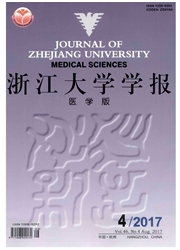

 中文摘要:
中文摘要:
目的:分析急性大动脉闭塞的缺血性卒中患者基线磁敏感加权成像(SWI)上毛刷征与静脉溶栓后发生出血转化的相关性。方法:回顾性分析2009年8月至2014年10月期间在浙江大学医学院附属第二医院神经内科接受静脉溶栓治疗的前循环大动脉闭塞(颈内动脉、大脑中动脉M1和M2)患者,在SWI图像上将两侧静脉显影程度评分相减(患侧.健侧)得到不对称指数(AI)。采用有序logistic回归分析毛刷征的影响因素,二元logistic多元回归分析静脉溶栓后出血转化和毛刷征之间的相关性。最后分析毛刷征联合早期再灌注对出血转化的影响。结果:最后纳入分析66例患者,平均年龄(68-4-13)岁,女性22例(占33%),男性44例(占67%),共计26例(39.4%)患者出现出血转化。根据AI将其分为三组:AI=0(n=9)、AI=1(n=39)、AI=2(n=18)。各组间出血转化率差异有统计学意义(P=0.026)。二元logistic回归分析显示,AI分级升高(即毛刷征越显著)是急性缺血性卒中患者溶栓后发生出血转化的独立危险因素(OR=2.589,95%CI:1.080—6.210,P=0.033)。非再灌注亚组分析结果提示毛刷征越显著者出血转化率越高(P=0.023)。结论:SWI毛刷征与急性缺血性卒中患者静脉溶栓后发生出血转化相关,有临床预测价值。
 英文摘要:
英文摘要:
Objective : To assess brush sign ( BS ) on susceptibility-weighted imaging (SWI) in prediction of hemorrhagic transformation (HT) in patients with acute ischemic stroke (AIS) after intravenous thrombolysis (IVT). Methods: Patients with acute cerebral ischemic stroke, who had major cerebral artery occlusion (internal carotid artery, middle cerebral artery M1 and M2 ), treated with intravenous recombinant tissue plasminogen activator (rt-PA) from August 2009 to October 2014 in the Second Affiliated Hospital, Zhejiang University School of Medicine, were enrolled in the study. All patients underwent SWI scanning. The asymmetry index (AI) was defined as the difference of intensity between ischemic and normal hemispheres on the SWI phase map; according to AI values patients were divided into 3 groups: BS = 0 (n =9), BS---1 (n =39) and BS =2 (n = 18). The relationships between BS and HT and the clinical outcome among the 3 groups were analyzed. Results: Sixty-six patients aged 68 ± 13 years were included in the study, including 44 males (67%) and 22 females (33%), and 44 (67%) with acute ischemic stroke. The mean pre-treatment National Institutes of Health Stroke Scale (NIHSS) score was 13 (6- 17), and the onset to needle time was (252 ± 88 )rain. Twenty-six (39.4%) patients had HT, including 18 cases (27. 3%) with HI and 8 cases (12. 1%) with PH; BS was observed more frequently in HT group than non-HT group. Binary logistic regression analysis showed that BS was independently associated with HT of patients with acute ischemic stroke following IVT (OR =2.589, 95%CI: 1.080 -6.210, P =0.033). In those without reperfusion after IVT, patients with higher BS grade had higher HT rate (P =0. 023 ). Conclusion: Brush sign on SWI can be used for predicting hemorrhagic transformation after intravenous thrombolysis in patients with acute ischemic stroke.
 同期刊论文项目
同期刊论文项目
 同项目期刊论文
同项目期刊论文
 Evaluation of Brain Iron Content Based on Magnetic Resonance Imaging (MRI): Comparison among Phase V
Evaluation of Brain Iron Content Based on Magnetic Resonance Imaging (MRI): Comparison among Phase V Extensive cerebral microbleeds predict parenchymal haemorrhage and poor outcome after intravenous th
Extensive cerebral microbleeds predict parenchymal haemorrhage and poor outcome after intravenous th Rosiglitazone attenuates hyperglycemia-enhanced hemorrhagic transformation after transient focal isc
Rosiglitazone attenuates hyperglycemia-enhanced hemorrhagic transformation after transient focal isc Morphology of susceptibility vessel sign predicts middle cerebral artery recanalization after intrav
Morphology of susceptibility vessel sign predicts middle cerebral artery recanalization after intrav No Hemorrhagic Transformation after Intravenous Thrombolysis in a Pontine Infarction Patient with Ba
No Hemorrhagic Transformation after Intravenous Thrombolysis in a Pontine Infarction Patient with Ba Statin Withdrawal Beyond Acute Phase Affected Outcome of Thrombolytic Stroke Patients An Observation
Statin Withdrawal Beyond Acute Phase Affected Outcome of Thrombolytic Stroke Patients An Observation Different risk factors for poor outcome between patients with positive and negative susceptibility v
Different risk factors for poor outcome between patients with positive and negative susceptibility v 期刊信息
期刊信息
